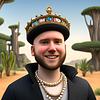Take a photo of a barcode or cover
Sometimes a bit scattered, sometimes a bit over the top, the book is nonetheless an excellent history of the pandemic influenza of 1918, the medical and scientific developments beforehand that caused us to think we might conquer it, and the knowledge gained in its aftermath.
This is a great and scary book on the misnamed Spanish Flu. Rather than some dry text, he brought me into that terrifying time. He started in Kansas, where evidence strongly indicates that this was the starting point (not Spain), then dived into the history of American medicine. I had no idea that doctors were jokes even as late as the late 1800's, that medical colleges basically were, if the check cleared, and you said here during rollcall in lectures, you became certified doctor, without seeing a single patient or visiting any labs. I thought he did a good job explaining the influenza virus, how it so quickly mutates, and why in this particular plague, why so many young and healthy young men and women died so much more frequently than the old. President Wilson's reponses to WWI was quite interesting, I had no idea how much America almost became totalitarian with respect to dealings with the war and those who disagreed or even questioned about Germany and WWI. Decisions to paint a rosy picture in spite of overwhelming evidence that this flu was deadly and with no real way to fight it in spite of the best efforts by America's best and brightest until it was too late and people started dying was quite interesting and somewhat reminiscent of China's response to SARs a few years ago. His new afterword was sobering, especially in light of the simple fact that epidemiologists think it's a matter of when, not if, another deadly outbreak occurs, and that we are even less prepared than the people of 1918 with the just-in-time business processes that ensures we quickly run out of hospital beds and coffins once a real outbreak occurs, flooding hospitals with patients, and morgues with the dead.
Highly recommended!
Highly recommended!
Interesting topic, but the execution was not so good. This book is repetitive to the point that I wondered if there was an editor. The author repeats the same facts over and over again. A large chunk of this book could be removed without losing much, if any, material.
I wanted to like this book. It's been on my to-read shelf for years. Still... I didn't. The research is top-notch. This is actually the downfall. The author took all his in-depth research and went all over the place in the book. It was scattered, unorganized, and poorly edited. So many parts of the book were completely unnecessary or just repetitious. I doubt I would recommend this to anyone except a doctor or a student of infectious diseases. There has to be something else out there that tells this story better.
emotional
informative
sad
slow-paced
informative
slow-paced
Fairly well written and engrossing, particularly in the face of the current pandemic fears. This tale of the rise of modern scientific medicine in the US and how it, along with WWI, impacted the 1918 flu pandemic was a great read. I could have done without a few of the literary dramatic flourishes, but overall the statistics and science are both stunning and sobering.
Nothing like I thought it would be. I was hoping for a medical history of how the 1918 flu impacted civilization. I mean, is it so wrong to think the book’s description of itself would be accurate? Instead, it was a disorganized and meandering biography of various scientists who failed in so many ways.
Droning on and on about this scientist and that scientist, their wives, why they chose to work at a certain lab-the book only sprinkles in stories of civilization impact. Considering it took Barry 7 years to write this, I think he completely lost his way. Better described as a biography on scientists.
Droning on and on about this scientist and that scientist, their wives, why they chose to work at a certain lab-the book only sprinkles in stories of civilization impact. Considering it took Barry 7 years to write this, I think he completely lost his way. Better described as a biography on scientists.
This book was not what I expected. More than 50 percent of the book is about the sorry state of American medicine leading up to and during the 1918 pandemic and the scientists that changed everything for the better while trying to figure out the cause of the pandemic. It was hard keeping track of the many different scientists followed throughout. I was hoping the book would document in detail the closing of schools, businesses, churches, mask wearing, etc. and give answers as to their effectiveness in the spread of a pandemic (too see if we learned anything and applied it to the COVID-19 pandemic). In the afterword he mentions he planned to write the book in 2.5 to three years, but after he started adding the history about American medicine and the stories about the scientists it ended up taking seven years. That should’ve been his first clue, or his editor’s first clue, to break it up into two books or stay focused on the original topic.
Rambles a bit at the end.
However, and it's a big however, the epilogue written for the 2018 edition is a must: it is prophetic.
However, and it's a big however, the epilogue written for the 2018 edition is a must: it is prophetic.


